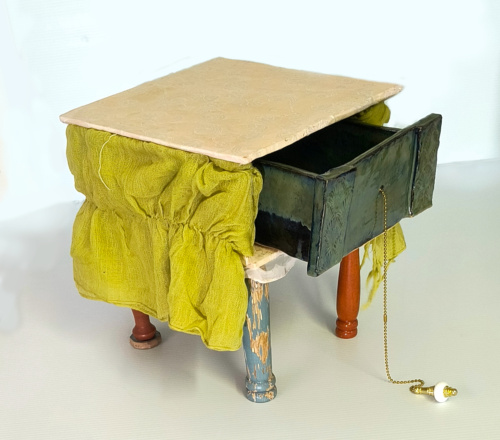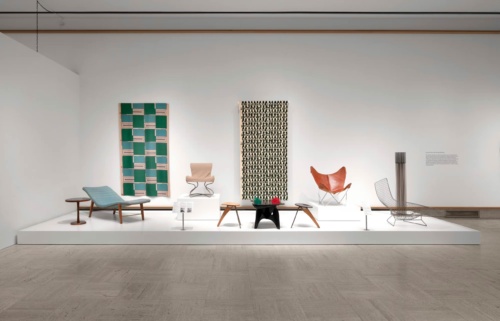Elliot Earls Is Featured in “DDEAF Magazine”
Learn more about Artist-in-Residence and Head of 2D Design Elliot Earls in DDEAF Magazine‘s summer issue.
Elliott Earls interview by Kim Fay, DDEAF Magazine
When writers, musicians, actors earn income and royalties from their craft, it’s a reflection of their talent and popularity. A painter paints because she loves it. If she paints to get paid, her work is tainted. It’s not pure. Books, songs and movies are scalable. They can be replicated millions of times and sold. A painting is an original piece. The artist herself can’t perfectly reproduce her own work even once. Shouldn’t that be worth more? Why the double standard
Because of an ear. Accounts vary as to whether it was the entire ear or just a portion, it revealed Vincent van Gogh’s mental instability and lead to his being sent to a hospital. He never sold a painting in his lifetime. He traded a couple for rent. His brother Theo helped him out financially. His legend grew into the brilliant but tragic painter. Our romance with the tormented starving artist was born. Truth and agreement. If we agree the world is flat, it’s flat. We’ve agreed that artists struggle. Well, stop it. Vince didn’t have a cell phone bill. Or a mortgage. Or kids.
Sotherby’s and Christies’s action artwork for millions. It is true that a lot of artists are dead. Because the artists won’t be making any more originals, the body of work is now finite causing the price to go up. But, some of those artist are alive and well and have all their appendages. The reason I make the work isn’t likely the reason you buy the work. You buy it because you like it. Or it matches your couch. If your money is green, I really don’t care what color your couch is. If you like my work, great. If you really like it, show me the money. My car payment is due.
Is there a distinction between art and design?
In 2016, we live in a trans-disciplinary age. If you fire up YouTube, it’s extremely hard to tell the difference between work produced by a performance artist, an advertising agency or some kid in his room with a PC. My po9int is that barriers between disciplines have been eroded through technology. I don’t really see clear cut distinctions between design and art. In every area of our culture, categories are really fuzzy.
You’ve talked a lot about what’s not valued in art and design, what IS valued?
It depends on whether you are talking among artists or if you’re talking about the art market. The art and design market among collectors, values craft, manufacturing. These things in any artist’s or designer’s studio can be seen as extremely well made baubles. Outside of the art market I think there are a couple things that are valued, and in some ways, don’t have as much to do with craft as much as it has to do with a relative uniqueness of vision and point of view.
You recommended that your followers make work that is aesthetically sophisticated. What is that and how do you know?
That’s a good question. How do you know? I think you can tell by a culturation. The way you develop that is being exposed to a lot of contemporary art and design. Then there are people that are just innately visual. Art and design aren’t limited exclusively to the visual. But aesthetically sophisticated work is work that, simply put, looks good. Everyone is going to have their opinion about that.
Culturally we have become increasingly narcissistic, mostly due to the advent of social media. You rail against an artists’ work containing elements of narcissism citing Shakespeare as an example of talent minus hubris. Yet, aren’t your videos narcissistic?
I explicitly point that out. I think I say, “Any time you see the artist in their own work”, and immediately show a clip of me in a feature length film. I point those out because I’m being honest that I’m subject to that, too. I fully realize that a YouTube video series is the definition of narcissism. A lot of instances where the self, myself, has come up, I don’t see things clearly. I’m attempting to talk about something that I know every well. We live in a culture where everybody is a rock star. Everyone gets a trophy. People don’t have an accurate picture of what their own skill set is.
How can art assist in the fight against the forces of stupidity?
By making work that demands attention. You can make work that is more visual pop, or you can make work that’s not just visual; it demands that you think it through. You fight stupidity by making work that when a person stands in front of it, in order to deal with it, they have to think about its complexities. Not everyone will do that. But there is a segment of our culture that will. So I try to make that kind of work.
How important is it to get paid for your work?
It’s extremely important albeit not a very fashionable thing to say. Of course I’m pointing to the top of the food chain, but if Takashi8 Murakami doesn’t think he can get paid for his work… where is this idea that our work should be free? I’ve got three kids. I value education. Probably the single most expensive thing in our culture these days, not a luxury item, is education. I also want to do this for a living. Lil Wayne says if you’re smart and you grind, the money comes. Not everybody has that as a goal. Not everybody is concerned about money. I make work for the love of making work first, but if you are concerned about paying for a kid’s education, you need to get paid. The top 1% of artists, admittedly a very small number, make more money than professional basketball players, than some CEO’s. There’s an artifical distinction that art is somehow sullied by money. Gimme a break. Other artistic disciplines don’t have any problem with it. You have to build a market for your work. You have to cultivate people who will actually pay money for your work. I think it’s hard as shit, but I think it’s possible.
Do you have any observations about Detroit and the art community here?
I think it’s amazing what’s happening here. Cranbrook Academy of Art would not exist without Detroit. It’s part of the greater metropolitan area. I went to graduate school here, coming from the New York/Connecticut area. In the ‘90’s people came to school here and they left. Now I’d say 50% or more of my graduate students have stayed. They realize what an opportunity Detroit is. It’s like the wild wild west. There’s very little oversight. The cost of living is still extremely low. The cliché “in crisis there’s opportunity” is true. Seems like on eof the big beneficiaries for the city is the art community.
Check out more of Elliott Earls’s work at www.elliottearls.com


